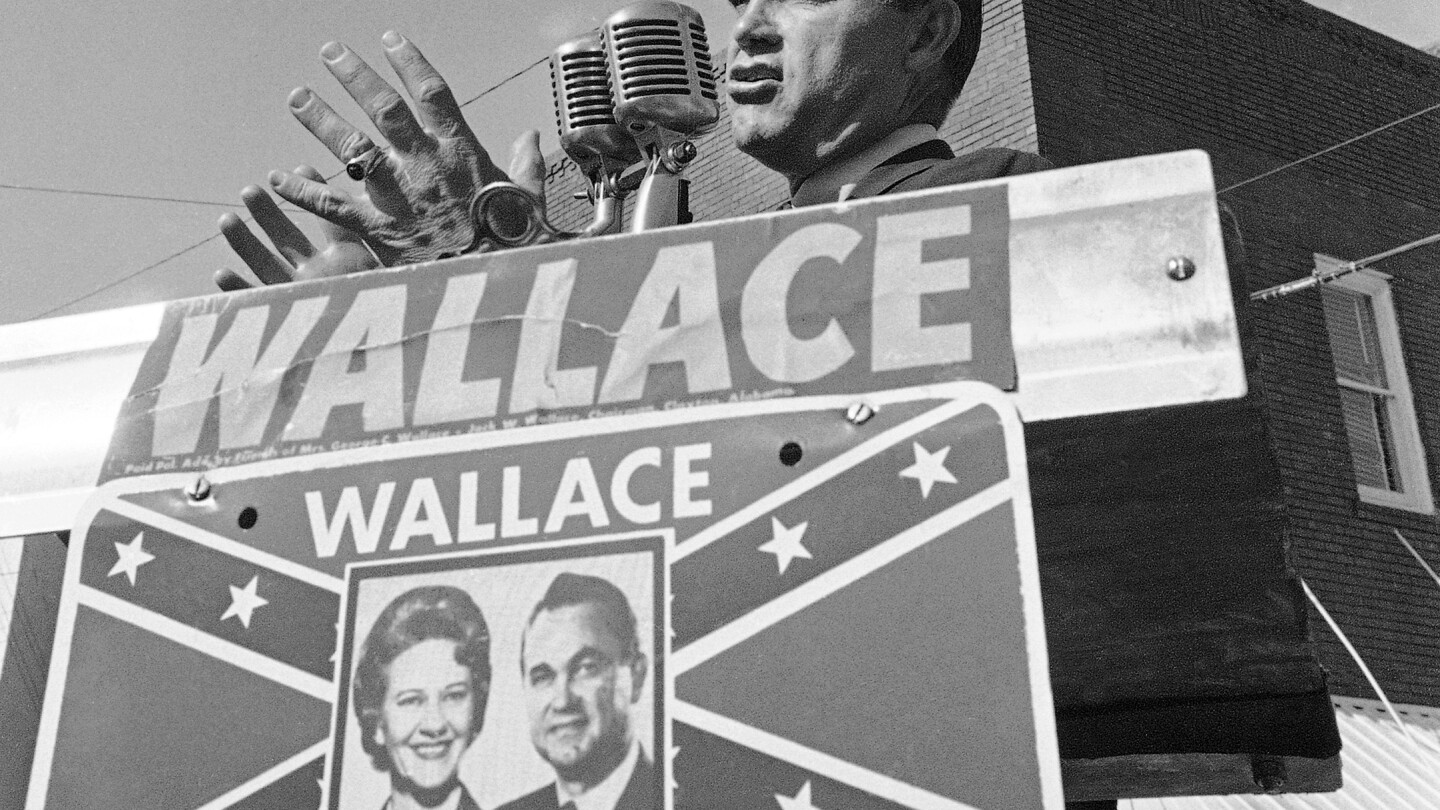Alabama
The next Republican debate is in Alabama, the state that gave the GOP a road map to Donald Trump

ATLANTA (AP) — Republican presidential candidates will debate Wednesday within walking distance of where George Wallace staged his “stand in the schoolhouse door” to oppose the enrollment of Black students at the University of Alabama during the Civil Rights Movement.
The state that propelled Wallace, a Democrat and four-term governor, into national politics is now dominated by Republicans loyal to Donald Trump, another figure who leans heavily on grievance and white identity politics. The former president will not be on stage in Tuscaloosa but remains the prohibitive favorite to win Republicans’ nomination again.
Alabama’s path since Wallace ‘s rise helps explain the 2024 dynamics and how Republicans evolved nationally from the Party of Lincoln into the Party of Trump. Certainly, Trump argues he helps all races as a defender of everyday Americans forgotten by Washington elites. He even uses that as a defense against four criminal indictments, accusing establishment powers of attacking him as a way to quash citizens. That sort of approach resonated in conservative strongholds like Alabama long before Trump.
“Alabamians, and I think most people, just don’t like to be told how to live,” said former state Republican chairwoman Terry Lathan, referencing Alabama’s motto: “We dare defend our rights.”
For Wallace, that meant fighting federal authorities on integration and then running nationally with the slogan “Stand Up for America.” Trump set up his 2016 rise by spending years questioning the citizenship of President Barack Obama, the first Black president. Like Wallace, Trump is backed strongly by culturally and religiously conservative whites moved by his slogan: “Make America Great Again.”
“Different from Wallace, but Donald Trump is offering a form of nostalgia,” said national GOP pollster Brent Buchanan, who founded his Washington-based firm, Cygnal, in Alabama.
Historian Wayne Flynt said the common thread across the eras is a swath of voters “who feel they are not paid attention to … that there’s not much future for them.” Trump, like Wallace, he said, has “brilliantly analyzed the angst and anxiety.”
That doesn’t mean Alabama Republicans are in lockstep. Lathan, who said “we know how wrong Wallace was” for his racism, backed Trump during her chairmanship. Now she supports Ron DeSantis; she called the Florida governor a “Reagan conservative who gets things done without being a bully.”
But, she acknowledged Trump’s “steamroller effect” makes him “very popular in Alabama.”
Wallace, a four-time presidential candidate, was governor for 16 years spread from 1963 to 1987. That period marked a Southern political realignment, spurred in part by President Lyndon Johnson signing civil rights legislation in the 1960s: Democratic-controlled states shifted to Republicans in presidential politics and, later, other offices.
Alabama Democrats, especially, cite deep historical roots involving racism, class and urban-rural divides when explaining Wallace, Trump and the decades between them.
“To understand it, you really have to go back to the Civil War and Reconstruction,” said Bill Baxley, a former state attorney general and lieutenant governor.
Now 82, Baxley said he knows how stereotypically Southern that sounds. But it’s fact, he said, that Republicans being the “Party of Lincoln” made white Southerners vote Democratic for generations after the 16th U.S. president won the war.
The more layered reality of the so-called “Solid South” was that two unofficial parties operated under one banner. Moderate to progressive “national Democrats” were concentrated in north Alabama, Baxley explained, while reactionary “states-rights Dixiecrats” cohered in south Alabama. Not coincidentally, south Alabama is where plantations anchored the antebellum slavery economy. Politics became “economic populism in the north,” Baxley said, and “race-issue populism” in the south.
Those fault lines shaped Democratic primaries until the late 20th century. National Democrats claimed more federal than state offices: Baxley listed Alabamians instrumental in President Franklin Roosevelt’s New Deal programs that paved roads, built hospitals, ran electrical and telephone lines, and spurred development in rural areas mired in poverty even before the Great Depression.
Then “Wallace came along as a talented politician who figured out how to bridge all that better than anybody else,” Baxley said, adding his disappointment that Wallace still made segregation his main argument.
Dixiecrats’ shift to Republicans accelerated in 1964, the first presidential election after Johnson, a Democrat from Texas, signed the Civil Rights Act. Republican challenger Barry Goldwater opposed the act and won five Deep South states. It was Alabama’s first flip from Democrats since Reconstruction.
Wallace won four Deep South states as an independent in 1968. Yet in 1970, he secured his second term as governor only through a close Democratic primary runoff. That same electorate made Baxley attorney general. An unapologetic national Democrat, Baxley prosecuted Ku Klux Klan members who bombed Birmingham’s 16th Street Baptist Church in 1963, and he memorably told a Klan leader in an open letter to “kiss my ass.”
Meanwhile, Wallace retooled his pitch for a national audience. He sneered about “inner-city thugs” and a “liberal Supreme Court” and Washington “overreach” — a coded version of his Alabama campaigns. It wowed working-class Democratic primary audiences beyond the South. Flynt, the historian, said Trump “does best almost exactly where George Wallace did best, and for many of the same reasons.”
In 1968 and 1972, Wallace held raucous rallies, railing against protesters. At New York City’s Madison Square Garden he said such behavior in Alabama “gets a bullet in the brain.” Wallace’s 1972 campaign ended with a bullet in his spine; it paralyzed him from the waist down.
Richard Nixon wrote in his memoirs that he adopted the “Southern strategy” — law-and-order and cultural rhetoric similar to Wallace’s — to stave off Wallace. Ronald Reagan employed his versions in 1980 and 1984 landslides.
Since Wallace’s first presidential bid in 1964, Alabama’s electoral votes have gone to a Democrat once: Jimmy Carter, a neighboring Georgian, in 1976. Even then, Carter sought Wallace’s endorsement after defeating the governor in Florida’s presidential primary.
After Reagan’s inauguration, Alabama’s down-ticket races still turned on what candidate could bridge economic populism and cultural conservatism, said Democratic pollster Zac McCrary, whose firm worked for Hillary Clinton’s and Joe Biden’s presidential campaigns.
“Democrats won when they were able to play up economic sentiments and turn down the volume on the culture wars,” McCrary said. In office, they implemented more liberal economic policies at the state level, especially K-12 education spending.
Wallace won his fourth term as governor in 1982 after disavowing segregation and winning over enough Black voters. Democrats won U.S. Senate seats, including recently retired Sen. Richard Shelby’s 1986 victory. Shelby switched parties to the GOP only after Republicans’ 1994 midterm romp driven by Newt Gingrich, the eventual House speaker whom Wallace biographer Dan Carter called an heir to the Alabama governor’s legacy.
In 1996, Alabama’s other Senate seat flipped. Jeff Sessions, a staunch conservative and lifelong Republican, went on to become the first U.S. senator to endorse Trump’s 2016 presidential bid, giving him high-profile validation on his way to the nomination. Trump made Sessions attorney general but ultimately fired him.
Alabama voters had previewed the turn to Trump: While Republicans nominated moderates John McCain and Mitt Romney for president in 2008 and 2012, Alabama’s primaries went to conservative populists Mike Huckabee and Rick Santorum. Between those elections, Republicans finally took control of the Alabama Legislature in the first midterms after Obama’s election.
Today, Alabama’s two U.S. senators represent two styles of Republican politics, offering a rough analogue to Southern Democrats’ split in Wallace’s heyday.
Sen. Tommy Tuberville is a Trump acolyte. He talked to Trump from the Senate floor as Trump supporters began storming Capitol Hill on Jan. 6, 2021; now he’s blocking military promotions to protest Pentagon policies for servicemembers seeking abortions.
Sen. Katie Britt, meanwhile, is a former head of the state chamber of commerce and chief of staff to Shelby, the old-guard dealmaker first elected as a Democrat. Like her old boss, Britt operates more behind the scenes and campaigns generically on “conservative Alabama values.”
Still, as Shelby did, she avoids criticizing Trump.
Buchanan, the Republican pollster, said: “It’s Donald Trump’s world and we’re all just living in it.”
—- Associated Press reporter Kim Chandler contributed from Montgomery, Alabama.

Alabama
West Alabama Works to grow modern manufacturing program with increase in state funding

TUSCALOOSA, Ala. (WBRC) – West Alabama will lead modern manufacturing efforts in schools around the state.
The state legislature recently approved a financial boost that will help a group in that part part of the state coordinate training for students for years to come.
Millions of dollars from the state’s education trust fund will pay for West Alabama Works to train high school instructors in modern manufacturing. The state allocated an additional $1.5 million to expand modern manufacturing classes in our schools. bringing the total to nearly $2.5 million.
West Alabama Works has been contracted to run modern manufacturing training programs statewide in K-12 schools.
That training includes working with instructors and showing them creative ways to teach the trade to students. It’s relatively new in career tech programs.
Modern manufacturing courses tie those students in with jobs when they finish the program.
“Our students can come in that two-year program, four semesters, and they come out with a job, a possible AAS degree, seven to 10 stackable credits,” explained Donny Jones, Executive Director of West Alabama Works. “But, most importantly, they’ll be making great money.”
More than 31 Alabama schools have modern manufacturing programs or will have them by Fall of 2024.
Nearly 1,700 students in Alabama are enrolled in high school modern manufacturing programs, according to Jones.
Get news alerts in the Apple App Store and Google Play Store or subscribe to our email newsletter here.
Copyright 2024 WBRC. All rights reserved.
Alabama
Will your child have to repeat 3rd grade under Alabama Literacy Act? Some exemptions, opportunities for retesting

BIRMINGHAM, Ala. (WBRC) – The Alabama Literacy Act went into full effect this past Friday after the state released third grade student reading scores for the school year. State education leaders want parents to know that just because your child didn’t meet the reading requirements, it does not mean they have to repeat third grade.
According to the scores, 9% of third graders, roughly 4,800, are not reading well. However, the Alabama Educators Association says under the act, there are a few exceptions made for some students so they won’t have to repeat:
- If a child is in their first two years of learning English language, they will not be required to repeat based off their reading scores.
- If a child has a disability, then they may have an alternative set of learning standards they’re required to meet, excluding them from meeting the reading test scores on the ACAP.
- If child has disability and they have already been retained once in kindergarten, 1st grade or 2nd grade, and have received at least two years of intensive remediation, they may be exempt from repeating the grade.
- If a child has been retained two years, and has received reading remediation for two years, the child can apply to move forward a grade with a continued focus on reading.
There are also opportunities for students to re-test this summer, so if they were close but didn’t meet the proficiency level, they will have the opportunity to try again.
“There’s a lot of data and science behind allowing students to stay with a particular peer group, so all of this is intended to sort of merge the two interests so that the child does not stay too far behind,” said William Tunnell, the Northern Region Manager for the Alabama Educators Association.
State education leaders say you’ll want your child to prepare before they re-test, and they recommend talking with your child’s school to determine a plan for success.
Get news alerts in the Apple App Store and Google Play Store or subscribe to our email newsletter here.
Copyright 2024 WBRC. All rights reserved.
Alabama
Family from Africa's Burundi join Alabama State University student for graduation – Alabama News Center

-

 News1 week ago
News1 week agoSkeletal remains found almost 40 years ago identified as woman who disappeared in 1968
-

 World1 week ago
World1 week agoIndia Lok Sabha election 2024 Phase 4: Who votes and what’s at stake?
-

 Politics1 week ago
Politics1 week agoTales from the trail: The blue states Trump eyes to turn red in November
-

 World1 week ago
World1 week agoBorrell: Spain, Ireland and others could recognise Palestine on 21 May
-

 Movie Reviews1 week ago
Movie Reviews1 week ago“Kingdom of the Planet of the Apes”: Disney's New Kingdom is Far From Magical (Movie Review)
-

 World1 week ago
World1 week agoUkraine’s military chief admits ‘difficult situation’ in Kharkiv region
-

 World1 week ago
World1 week agoCatalans vote in crucial regional election for the separatist movement
-

 Politics1 week ago
Politics1 week agoNorth Dakota gov, former presidential candidate Doug Burgum front and center at Trump New Jersey rally















